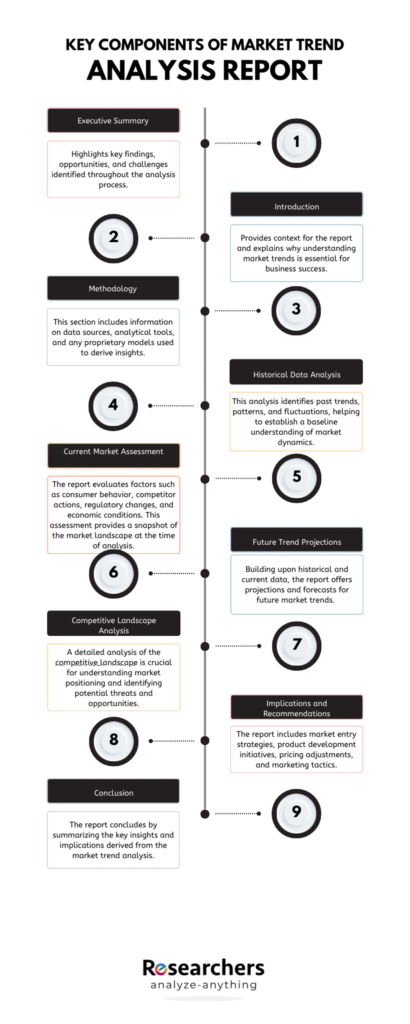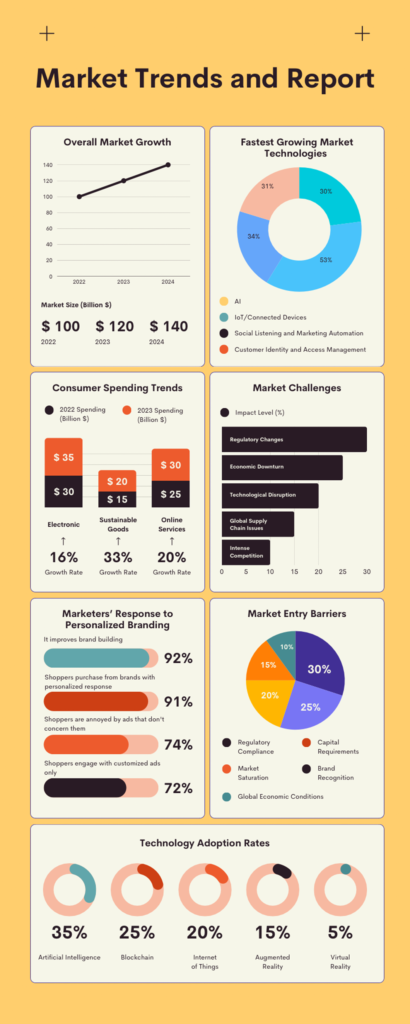We create businesses and brands for a purpose. Whether wealth generation, reputation, or passion, no one starts a business without envisioning success.
Now, what happens when you start in a new market and have to figure out why things are not playing out as you dreamed? How do you figure out where the problem is coming from? Is it specific to your brand or the niche you belong to? Are they trends you happen to be unaware of?
All these questions (and then some) are answered by thoroughly studying market trends. Companies that leverage market trend analysis effectively experience, on average, a 20% increase in profitability compared to those that do not. Businesses regularly conducting market trend analysis are 73% more likely to enter new markets successfully.
Businesses that tailor their products and services based on market trends experience a 15% increase in customer retention rates. A study in 2017 acknowledged that new companies take note of their market size even before attempting to establish. How can you possibly ensure you’re taking the right step when you have no idea who your buyers are supposed to be?
Let’s begin the journey on how you can upgrade your business to stand a winning chance on a global scale!
What Does A Market Trend Analysis Report Look Like?
A market trend analysis report is a comprehensive tool used to gain valuable insights into the dynamics of your marketplace. There are vital components you find in every report, and these include:
The Executive Summary
Highlights key findings, opportunities, and challenges identified throughout the analysis process.
Introduction
Provides context for the report and explains why understanding market trends is essential for business success.
Methodology
This section includes information on data sources, analytical tools, and any proprietary models used to derive insights.
Historical Data Analysis
This analysis identifies past trends, patterns, and fluctuations, helping to establish a baseline understanding of market dynamics.
Current Market Assessment
The report evaluates consumer behavior, competitor actions, regulatory changes, and economic conditions. This assessment provides a snapshot of the market landscape during analysis.
Future Trend Projections
Building upon historical and current data, the report offers projections and forecasts for future market trends. This stage leverages statistical models, trend identification tools, and expert insights.
Also Read:- A Comprehensive Guide to Market Trend Analysis
Competitive Landscape Analysis
A detailed competitive landscape analysis is crucial for understanding market positioning and identifying potential threats and opportunities. This section assesses competitor strategies, strengths, weaknesses, and market share dynamics.
Implications and Recommendations
These recommendations are based on the findings of the analysis. The report includes market entry strategies, product development initiatives, pricing adjustments, and marketing tactics.
Conclusion
The report summarizes the key insights and implications of the market trend analysis.

What Techniques Can Be Used to Analyze Your Market Trends?
Companies that proactively monitor and respond to market trends are 2.5 times more likely to outperform their peers regarding revenue growth. Leveraging predictive analytics and machine learning algorithms allows you to gain a competitive edge.
Analyzing market trends combines quantitative and qualitative techniques to uncover insights. Here are some fundamental methods for analyzing market trends:
Statistical Analysis
This uses statistical tools and methods to analyze sales figures, market share data, and pricing trends. Statistical analysis identifies patterns, correlations, and anomalies in the data. This information provides valuable insights into past market trends and forecasting future movements.
Time Series Analysis
This technique involves analyzing data collected over successive intervals to identify patterns and trends. Time series analysis helps you understand seasonal fluctuations, long-term trends, and cyclical patterns in the market.
Regression Analysis
Regression analysis is a statistical technique used to identify the relationship between variables and predict future outcomes. Examining the relationship between dependent and independent variables helps us forecast market trends. This model allows brands to make informed decisions based on predictive models.
Market Segmentation
Segmenting the market into distinct groups based on demographic, psychographic, or behavioral characteristics is sometimes all you need. Market segmentation allows you to identify niche markets. When you target specific customer segments, it helps you tailor your marketing strategies accordingly.
Competitive Analysis
Analyzing your rivals’ strategies, offerings, and positioning provides insights into market trends and dynamics. Monitoring their actions and reactions gives you an edge over emerging trends and threats to benchmark your performance against.
Consumer Surveys and Feedback
Gathering customer feedback through surveys, focus groups, and social media channels provides insights into consumer preferences, attitudes, and behaviors. Analyzing consumer feedback allows businesses to identify emerging trends, uncover unmet needs, and adapt their offerings to meet customer demands better.

Best Practices in Market Trends Reporting
Here are essential practices to ensure influential market trends reporting for your brand:
Accuracy and Reliability
- Ensure that the data used for analysis is accurate, reliable, and up-to-date.
- Clearly outline the methodology and techniques used for analyzing market trends.
- Validate findings through cross-referencing with multiple data sources and analytical approaches.
- Conduct peer reviews or internal audits of market trends reports to assess their accuracy, objectivity, and adherence to best practices.
- Peer review provides an additional layer of validation and enhances the credibility of the reported insights.
Timeliness and Frequency
- Leverage technology and data analytics tools to monitor market trends in real time.
- Establish a regular reporting cadence to provide stakeholders with timely updates on market trends (it could be weekly, monthly, or quarterly reports).
- In addition to regular reporting, be prepared to deliver ad hoc reports or updates in response to significant market events or developments.
Visualization and Presentation
- Use visual elements such as charts, graphs, and infographics to present complex data and trends clearly and understandably.
- Frame the market trends report as a compelling narrative that tells a coherent story about the state of the market and its implications for the business.
- Customize the reporting format and content to suit the preferences and needs of different stakeholders.
- Provide stakeholders access to interactive dashboards or reporting platforms to explore data and trends in self-service.
Conclusion
The importance of Market Trend Analysis cannot be overstated. We urge you to embrace and integrate market trends into your planning processes. Market trend analysis is a catalyst for innovation, agility, and resilience.
Chart a course towards a future of sustainable growth and prosperity with Researchers.me today!

